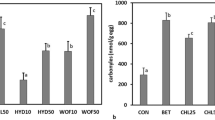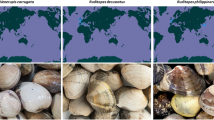Abstract
This study assessed the effect of immersing striped trumpeter eggs in 0 (control), 200, 400, 800, 1600 or 3200 ppm glutaraldehyde for 10 minutes, two days before hatching. High concentrations of glutaraldehyde (1600 and 3200 ppm) resulted in no eggs hatching and only 1% of eggs hatched after treatment with 800 ppm glutaraldehyde. Hatching success of eggs treated with 0, 200 or 400 ppm glutaraldehyde did not differ (77 ± 6%, n = 3). However, only 2% of larvae from the control treatment survived to day 5 post-hatching, compared to 45 and 69%, respectively of the larvae from the 200 and 400 ppm glutaraldehyde treatment. By day 9 post-hatching, larvae from the 400 ppm glutaraldehyde treatment had significantly higher survival (59%) than larvae from the 200 ppm glutaraldehyde treatment (28%). Thiosulphate citrate bile salt sucrose agar (TCBS) medium confirmed the presence of bacteria within the seawater medium, on all control eggs and on 83% of eggs disinfected with 200 ppm glutaraldehyde, but no bacterial colonies formed on eggs treated with 400, 800, 1600 or 3200 ppm glutaraldehyde. This study found highest survival of striped trumpeter larvae from eggs disinfected with 400 ppm glutaraldehyde and suggests that increased survival was a result of reduced bacterial loading.
Similar content being viewed by others
References
Austin B. 1988. Marine Microbiology. Cambridge University Press, 222 pp.
Cobcroft J.M., Pankhurst P.M., Sadler J. and Hart P.R. 2001. Jaw development and malformation in cultured striped trumpeter Latris lineata. Aquaculture 199: 267–282.
Harboe T., Huse I. and Øie G. 1994. Effects of egg disinfection on yolk sac and first-feeding stages of halibut (Hippoglossus hippoglossus) larvae. Aquaculture 119: 157–165.
Hempel G. 1984. Early Life History of Marine Fish: The Egg Stage. University of Washington Press, Seattle, 70 p.
Morehead D.T., Ritar A.J. and Pankhurst N.W. 2000. Effect of consecutive 9-or 12-month photothermal cycles and handling on sex steroid levels, oocyte development, and reproductive performance in female striped trumpeter Latris lineata (Latrididae). Aquaculture 189: 293–305.
Salvesen I. and Vadstein O. 1995. Surface disinfection of eggs from marine fish. Evaluation of four chemicals. Aquaculture International 3: 155–171.
Salvesen I., Øie G. and Vadstein O. 1997. Surface disinfection of Atlantic halibut and turbot eggs with glutaraldehyde: evaluation of concentrations and contact times. Aquaculture International 5: 249–258.
Skjermo J. and Vadstein O. 1999. Techniques for microbial control in the intensive rearing of marine fish larvae. Aquaculture 177: 333–343.
Trotter A.J., Pankhurst P.M. and Hart P.R. 2001. Swim bladder malformation in hatchery-reared striped trumpeter Latris lineata (Latridae). Aquaculture 198: 41–54.
Author information
Authors and Affiliations
Corresponding author
Rights and permissions
About this article
Cite this article
Morehead, D., Hart, P. Disinfection of striped trumpeter (Latris lineata) eggs with glutaraldehyde. Aquaculture International 11, 255–260 (2003). https://doi.org/10.1023/A:1024884620233
Issue Date:
DOI: https://doi.org/10.1023/A:1024884620233




